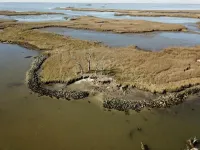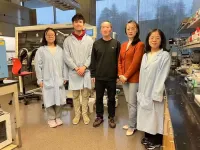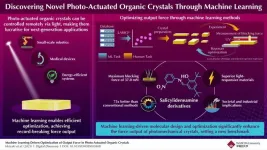(Press-News.org) Humans have always lived by coasts and waterways, and thus these locations are rich with archeological sites. Natural and cultural resource management are conducted separately, despite the fact that climate change, sea level rise, and extreme weather threaten them both. Jayur Mehta and colleagues argue a synergy of both approaches is required to protect coastal archaeological landscapes. The authors used LiDAR digital elevation models, site location data, and NOAA sea level rise models to define impacts and inundation of archaeological sites for the US Gulf coast regions of the Florida Big Bend and the Mississippi River Delta. In Florida’s Big Bend region, 11 Indigenous sites are already at or below sea level and a further 142 mound and midden sites could be submerged in the next century—including a monumental mound site known as Garden Patch. In the Mississippi River Delta, 11 Indigenous sites are at or below sea level and a further 107 mound and midden sites are at risk—including the Magnolia Mounds complex and the Bayou Grand Cheniere site. Similar risks exist for prehistoric sites in low-lying parts of the Netherlands, cultural heritage sites in Oceania, and archaeological sites in coastal Peru. In Peru, the rapid pace of agricultural expansion further exacerbates threats to cultural resources. The authors call for policies integrating coastal ecosystem management with archaeological and historical resource preservation, using Indigenous traditional ecological knowledge, and cultural-
ecosystem services approaches. According to the authors, coastal archaeological resources provide coupled ecosystems resilience in biocultural landscapes and that an integrated approach is necessary for preservation and restoration.
END
Coastal heritage threatened by climate change
2025-04-15
ELSE PRESS RELEASES FROM THIS DATE:
A tale of two hummingbird bills
2025-04-15
There are two species of streamertail hummingbirds on the island of Jamaica, West Indies—one with red-billed males (Trochilus polytmus) and the other with black-billed males (T. scitulus). This is a puzzling situation, as many evolutionary biologists have argued that avian speciation is unlikely to occur on small oceanic islands. Caroline Duffie Judy and colleagues investigated the hybrid zone that separates the two species, which is as narrow as 3.2 km. The authors analyzed 186 Trochilus specimens from 12 ...
Corn leads to improved performance in lithium-sulfur batteries
2025-04-15
PULLMAN, Wash. -- Researchers at Washington State University have demonstrated a way to use corn protein to improve the performance of lithium-sulfur batteries, a finding that holds promise for expanding the use of the high-energy, lighter-weight batteries in electric vehicles, renewable energy storage and other applications.
Lithium-sulfur batteries are lighter for the same amount of energy and more environmentally friendly than commonly used lithium-ion batteries, but their commercial adoption has been limited by technological hurdles that shorten their lifespan.
The WSU team’s research, published in the Journal of Power Sources, ...
SynGAP Research Fund (SRF), dba Cure SYNGAP1, announces Board of Trustees Update 2025
2025-04-15
Mill Valley, CA – April 15, 2025 – SynGAP Research Fund (SRF), dba Cure SYNGAP1, the leading patient advocacy group dedicated to improving the lives of those affected by SYNGAP1-related disorders (SRD), today announced the appointment of Jaime Aranda, Steve Gore, Heather Mestemaker, and Brian Smith to its Board of Trustees, effective April 15, 2025. They will succeed outgoing Trustees Emily Barnes, Sydney Stelmaszek, and Stella Tavilla, whose terms conclude on April 14, 2025. Additionally, a seat previously held by Pavel Gerovich, who stepped ...
Machine learning unlocks superior performance in light-driven organic crystals
2025-04-15
Materials that convert external stimuli into mechanical motion, known as actuators, play a crucial role in robotics, medical devices, and other advanced applications. Among them, photomechanical crystals deform in response to light, making them promising for lightweight and remotely controllable actuation. Their performance depends on factors such as molecular structures, crystal properties, and experimental conditions.
A key performance indicator of these materials is the blocking force—the maximum force exerted when deformation is completely ...
Exploring the mutational landscape of colorectal cancer
2025-04-15
Colorectal cancer (CRC), a type of cancer that affects the large intestine and rectum, is one of the leading causes of cancer-related deaths worldwide. The mutational landscape of CRC is well characterized, revealing key pathogenic genetic abnormalities that drive carcinogenesis (cancer development) and disease progression. Moreover, a step-wise colorectal carcinogenesis model has been proposed wherein normal epithelial cells transition to adenoma (non-cancerous tumor) and then to carcinoma (cancerous tumor) as they sequentially acquire genetic mutations.
Mutations ...
Researchers have mapped the hidden control system of vision
2025-04-15
Vision is one of the most complex functions of our brain and requires a seamless interaction between many different brain structures to decode shapes, colours, depths, and movements and turn them into a meaningful whole. Just like other brain functions, vision also depends on a balanced and controlled interaction between the chemical signals that "activate" and "brake" activity in the eye's cells – much like the accelerator and brake of a car. In research, the "brake" is known as GABA, which stands for gamma-aminobutyric ...
Key to the high aggressiveness of pancreatic cancer identified
2025-04-15
Barcelona, 15th April 2025. – Pancreatic cancer is one of the most aggressive cancers and has one of the lowest survival rates—only 10% after five years. One of the factors contributing to its aggressiveness is its tumor microenvironment, known as the stroma, which makes up the majority of the tumor mass and consists of a network of proteins and different non-tumor cells. Among these, fibroblasts play a key role, helping tumor cells to grow and increasing their resistance to drugs. Now, a study led by researchers from the Hospital del Mar Research Institute, IIBB-CSIC-IDIBAPS, ...
How proactive salmon conservation in the North Pacific can deliver global benefits
2025-04-15
April 15, 2025 | Portland, Oregon—A new study in the journal Fisheries shows how a salmon-focused ecosystem protection strategy in the North Pacific can deliver meaningful results in the global drive to protect biodiversity.
The approach, called the stronghold strategy, aims to proactively protect the world’s greatest remaining “strongholds”—a select group of salmon, steelhead, and trout systems that collectively comprise 119 distinct watersheds. According to Wild Salmon Center President & CEO Guido Rahr—lead author of the peer-reviewed study—salmonids center the strategy because they are both iconic and globally recognized ...
Blocking chemokine receptor increases effectiveness of glucocorticoids in multiple myeloma treatment
2025-04-15
Researchers at the VIB-UGent Center for Medical Biotechnology have discovered a promising strategy to improve treatment responses in multiple myeloma patients by blocking a protein that plays a key role in drug resistance. The study, published in Pharmacological Research, offers a potential new strategy to improve outcomes for patients whose disease has become less responsive to standard therapies.
Multiple myeloma (MM) is a type of blood cancer that affects the bone marrow. Patients are often treated with dexamethasone, a synthetic glucocorticoid frequently used in the clinic to regulate immune responses and slow cancer growth. However, as the disease progresses, many patients develop ...
Amount of sunlight reaching Earth’s surface varies over decades, researchers report
2025-04-15
The sun may rise every morning, but the amount of sunlight reaching the Earth’s surface can substantially vary over decades, according to a perspectives article led by an international research team. The article, published on March 15 in Advances in Atmospheric Science, suggests that stages of “dimming” and “brightening” correspond with increased air pollution and implementation of clean energy solutions, respectively.
“The amount of sunlight — which is solar ...








